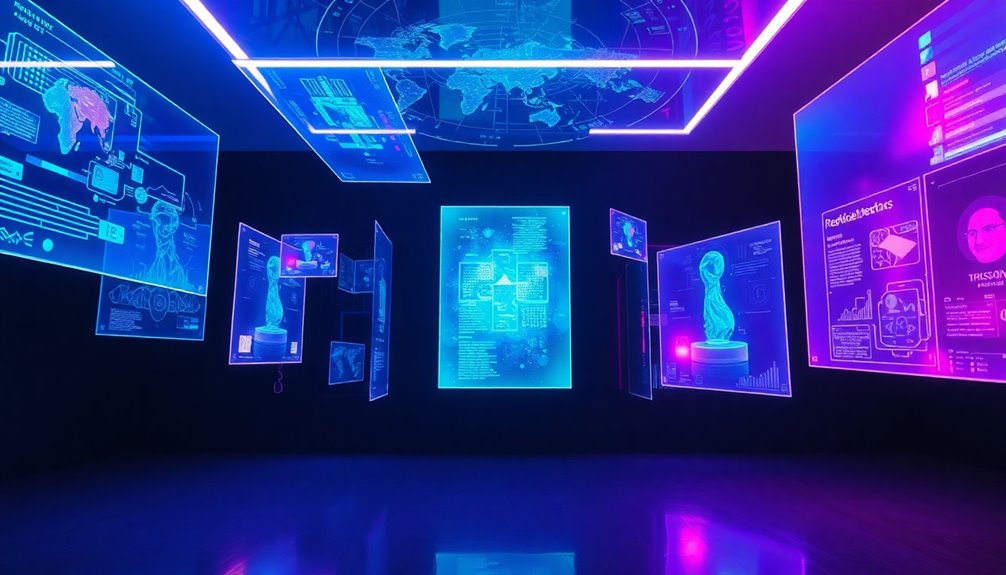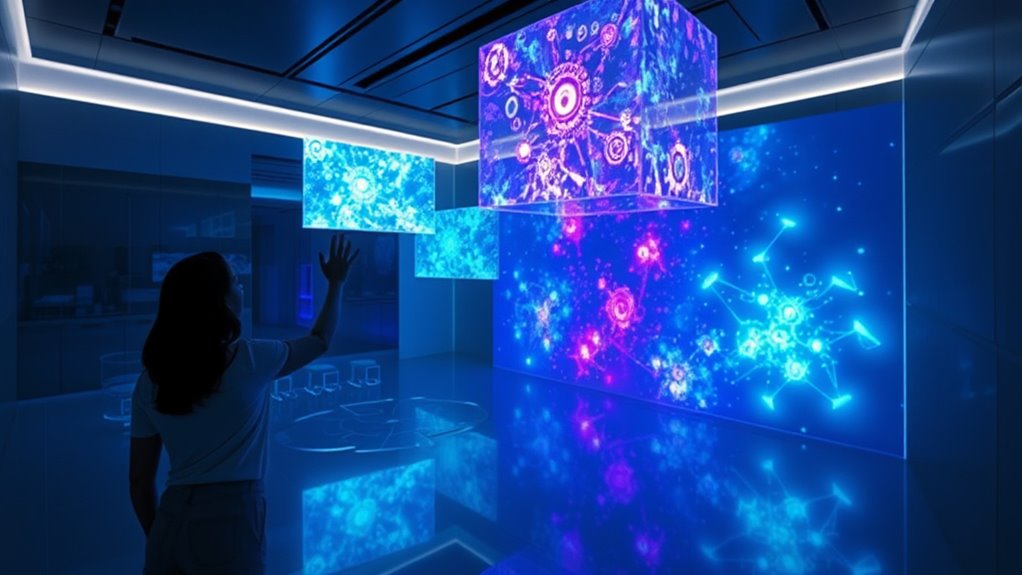Holographic displays are quickly moving from sci-fi fantasies to near reality, thanks to recent advances in laser tech, computational imaging, and optical components. They now offer immersive, true-to-life 3D visuals that are being integrated into healthcare, automotive, and entertainment sectors. While challenges like cost and technical complexity remain, innovations are making these systems more practical and accessible. Staying informed about these developments reveals how close we are to experiencing holograms in everyday life.
Key Takeaways
- Advances in holographic technology, like AI-driven algorithms and compact optical components, are making real-time, high-quality holograms feasible.
- Consumer-friendly holographic displays are emerging, with applications in healthcare, communication, and entertainment.
- Industry collaborations are accelerating development of automotive, medical, and AR holographic systems, moving beyond sci-fi visions.
- Challenges remain in reducing costs, increasing resolution, and expanding viewing angles, but ongoing research shows promising progress.
- Holography is transitioning from a sci-fi concept to practical, near-term applications shaping various industries.
How Holographic Displays Work and Their Visual Impact

Holographic displays create stunning 3D images by manipulating light through diffraction and interference. You’ll see how laser technology plays a key role, with lasers generating interference patterns that form intricate holograms. Spatial light modulators are essential, as they adjust the light beams to shape detailed 3D scenes. Special coatings on glass reflect digital content, creating the illusion of depth from specific angles. Electromagnetic resonators transmit stored image data, improving color accuracy and picture quality. The main components include high-definition screens, laser beams, and interference patterns, all working together to produce realistic, floating images. These displays deliver immersive visual experiences with impressive depth perception and wide viewing angles, making the images appear as if they’re truly in space. Additionally, color accuracy plays a crucial role in enhancing the visual fidelity of holographic images, ensuring vibrant and true-to-life colors. Advances in light manipulation techniques continue to push the boundaries of holographic display technology, promising even more realistic visuals in the future. Understanding the importance of display safety is also essential as these technologies become more widespread. Moreover, staying informed about the regional availability of such displays can help consumers and industries make better purchasing decisions. Furthermore, ongoing research in user interaction methods aims to improve how users engage with holographic content, making interfaces more intuitive.
Recent Breakthroughs Enhancing Image Quality and Usability

Recent advances in computational imaging algorithms are transforming the quality and usability of holographic displays. You can now achieve full-color 3D holograms on consumer-grade screens like smartphones, thanks to custom software that models incoherent light propagation for more realistic images. These algorithms simplify system design by reducing reliance on complex optical components, lowering costs, and enabling adaptive control of light wavefronts for sharper visuals. Additionally, tiny custom optical elements with etched patterns, designed with AI, improve image clarity and expand the field of view, creating more immersive experiences. Incorporating low-coherence light sources reduces speckle noise and system complexity, making holography more practical. Furthermore, the development of Vetted – Nightingale Studio optical components and algorithms continues to advance holographic display capabilities. These breakthroughs collectively push holographic displays closer to everyday use, offering higher quality visuals and enhanced usability for various applications. Moreover, ongoing research into light wavefront control techniques promises even greater precision and realism in holographic imaging, paving the way for more realistic visual experiences. Additionally, innovations in computational algorithms are enabling faster processing speeds, which are essential for real-time holographic rendering. As the field progresses, the integration of AI-driven design methods is expected to further optimize optical components and system performance.
Practical Uses Shaping the Future of Holography

Advancements in holography are actively transforming how you use this technology across various fields, making it more practical for everyday life. In healthcare, full-color 3D holograms help you visualize internal organs for accurate diagnosis and treatment. Digital holographic microscopy allows you to observe subcellular processes, aiding surgical precision. Surgeons can plan complex procedures with holographic displays and monitor patients during surgery with wearable devices, improving safety. In education, holograms of human organs create immersive learning experiences, while remote holographic lectures connect students worldwide. In communication, 5G-enabled holographic calls provide lifelike interactions, reducing the need for travel. Marketers leverage holograms for engaging advertising and product showcases. Additionally, restaurant hours today are crucial to consider when planning any related visits or events. As holography technology advances, the cost of hologram displays is expected to decrease, making it more accessible for widespread use. Moreover, ongoing research into holographic storage solutions promises even greater data capacity and security. These innovations are shaping a future where holography seamlessly integrates into your daily routines, enhancing efficiency and connectivity.
Overcoming Cost and Complexity Barriers in Development

Overcoming the high costs and technical complexities of holographic display development is essential for broader adoption. You’ll find that creating high-quality holograms demands advanced equipment like high-resolution projectors and specialized materials, which drive up expenses. Precision manufacturing processes, such as laser exposure and skilled labor, add to the complexity and cost, making large-scale production challenging. Smaller production runs are more expensive per unit, limiting affordability. However, innovations like miniaturized projectors, improved materials, and more efficient light engines are helping reduce costs. Software advancements streamline hologram design and rendering, decreasing resource demands. Collaborations focusing on modular components and hybrid technologies also aim to lower barriers. These efforts are key to making holography more accessible, paving the way for widespread use beyond niche markets. Additionally, ongoing research into cost-effective manufacturing techniques is crucial to overcoming financial barriers and enabling mass adoption. Developing scalable production methods is essential for transitioning holographic displays from experimental prototypes to commercial products. Moreover, leveraging natural materials and sustainable manufacturing practices can further help decrease overall costs and environmental impact.
Furthermore, integrating innovative manufacturing processes from related industries can accelerate the development of affordable holographic solutions.
Cutting-Edge Innovations Driving the Technology Forward

Cutting-edge innovations are rapidly transforming holographic display technology, bringing new possibilities across industries. Hyundai Mobis and Zeiss are developing panoramic windshield projections for EVs, displaying navigation and safety data seamlessly without obstructing your view. Mass production is set for 2027, enabling real-time AR overlays for traffic and weather, with AI expected to enhance safety alerts and dynamic routing. Swave’s HXR platform uses CMOS-based tech for ultra-detailed holograms in compact devices like smart glasses, merging digital and physical elements for healthcare and manufacturing. Spanish engineers’ FlexiVol system introduces touch-gesture manipulation of holograms, supporting medical visualization and collaborative design. AI-driven interfaces improve gesture recognition and predictive analytics, while innovations in aviation incorporate holograms into cabin windows with durable, energy-efficient displays. Additionally, advances in vegetable juices and other health-focused technologies are inspiring new ways to incorporate holographic interfaces into wellness and lifestyle applications. As holographic display technology advances, the integration of mental health benefits into holographic systems is becoming increasingly feasible, especially with the development of personalized content tailored to individual needs. These breakthroughs are rapidly pushing holography toward mainstream reality.
The Road Ahead: Opportunities and Obstacles for Mainstream Adoption

The road to mainstream adoption of holographic displays is filled with exciting opportunities that could revolutionize how you interact with digital content. Their versatility spans gaming, education, advertising, and entertainment, offering immersive experiences that boost engagement. Combined with AI, AR, and 5G, these displays could become more accessible and powerful. However, technical hurdles remain, like achieving high resolution, expanding viewing angles, and enabling real-time rendering. Hardware limitations and high costs also pose challenges, making widespread adoption initially limited to high-end markets. Content creation requires specialized skills, adding complexity. To succeed, costs must decrease, and awareness must grow. Additionally, ongoing technological advancements are essential to address current limitations and accelerate integration into daily life. Overcoming these obstacles could see holographic displays becoming a seamless part of everyday life, transforming how you learn, work, and play. Addressing cost reduction strategies will be crucial in making these innovations more affordable for the general consumer.
Frequently Asked Questions
What Are the Main Technical Hurdles to Achieving True Holographic Realism?
The main hurdles to achieving true holographic realism involve miniaturizing powerful hardware to fit wearable devices, improving spatial light modulators for larger, clearer images, and enhancing resolution and depth control. You also face challenges in real-time processing, reducing latency, and managing complex light patterns efficiently. Additionally, making these systems affordable and creating compelling content are vital steps to turn holography from science fiction into everyday reality.
How Soon Could Holographic Displays Become Affordable for Everyday Consumers?
You wonder when holographic displays will be affordable for everyday consumers. While high-end systems remain costly, ongoing innovations and manufacturing breakthroughs are lowering prices. As economies of scale kick in, expect more budget-friendly options in digital signage and AR hybrids before full home adoption. Experts project sub-$5,000 systems by the late 2030s, making immersive holographic experiences accessible, affordable, and part of daily life sooner than you might think.
Can Holographic Technology Be Integrated Seamlessly Into Existing Electronic Devices?
You wonder if holographic tech can be integrated smoothly into existing devices. Right now, it’s challenging because of technical hurdles like improving image quality, expanding field of view, and making flexible, lightweight components. Researchers are working on solutions like nano-holograms and adaptive surfaces, but widespread integration needs breakthroughs in fabrication, optics, and cost reduction. So, while promising, seamless integration still requires significant advancements before becoming commonplace.
What Environmental Factors Affect the Quality and Stability of Holographic Images?
You need to consider how environmental factors impact holographic images’ quality and stability. Variations in humidity and temperature cause distortion, fogging, and damage during fabrication. Ambient lighting and viewing angles influence visibility and clarity, while vibrations and mechanical instability lead to blurring. Dust, particulates, and electrostatic charges scatter light and cause noise. To maintain high-quality holograms, keep the environment controlled, clean, and stable, ensuring ideal conditions for image clarity and durability.
Are There Any Health or Safety Concerns Associated With Prolonged Holographic Display Use?
While holographic displays promise innovation, prolonged use raises health and safety concerns. You might experience eye strain or discomfort, especially without proper design or research. Privacy issues also emerge, as sensitive data could be vulnerable. However, advancements aim to improve comfort, safety, and data security. Staying informed and advocating for regulations helps mitigate risks, ensuring holographic technology benefits you without compromising health or privacy.
Conclusion
As you stand on the brink of holography’s future, remember that every breakthrough transforms sci-fi into reality—turning what once seemed impossible into everyday innovation. The horizon beckons with promise and challenge alike, like a double-edged sword illuminating new paths while demanding perseverance. Embrace these advancements, for they hold the power to reshape your world—if you dare to imagine beyond the limits of today, you’ll find holography waiting to redefine what’s possible.









